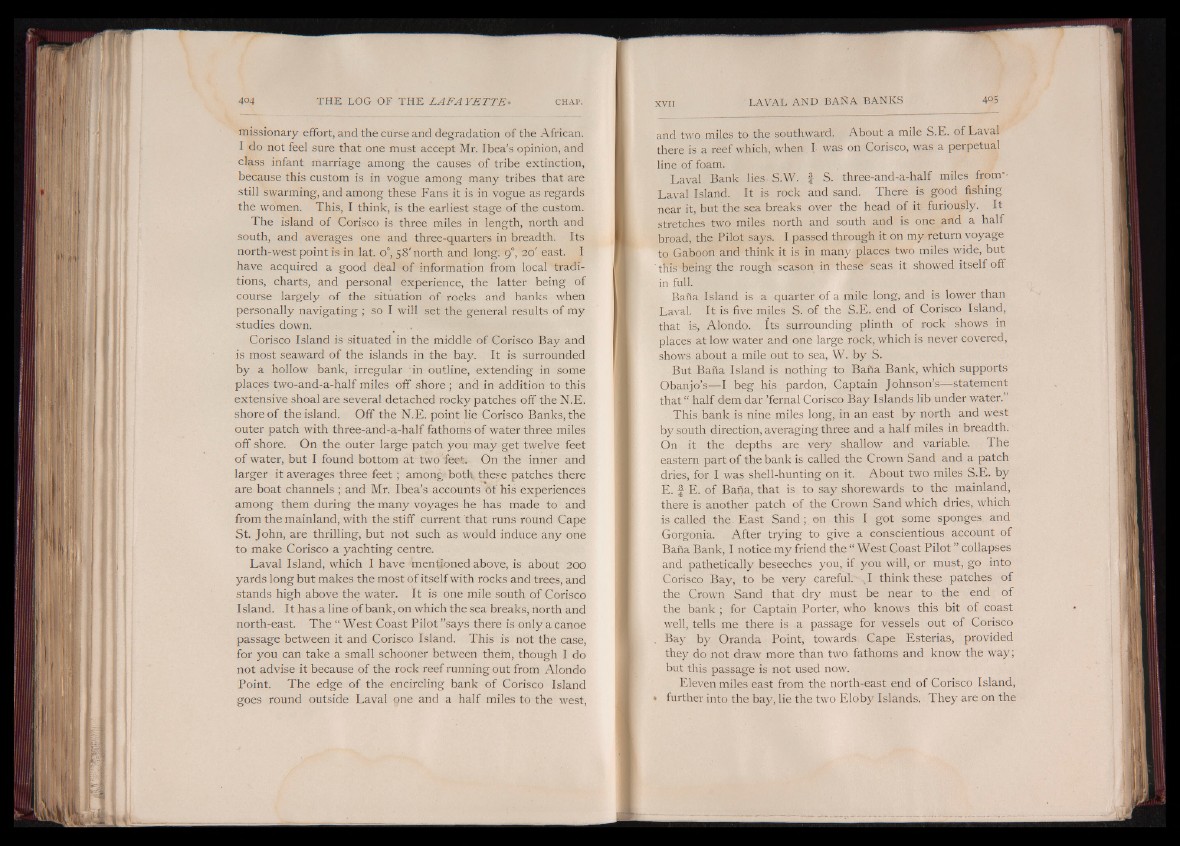
missionary effort, and the curse and degradation of the African.
I do not feel sure that one must accept Mr. Ibea’s opinion, and
class infant marriage among the causes of tribe extinction,
because this custom is in vogue among many tribes that are
still swarming, and among these Fans it is in vogue as regards
the women. This, I think, is the earliest stage of the custom.
The island of Corisco is three miles in length, north and
south, and averages one and three-quarters in breadth. Its
north-west point is in lat. o°, 58' north and long: 9°, 20' east. I
have acquired a good deal of information from local traditions,
charts, and personal experience, the latter being of
course largely of the situation of rocks and banks when
personally navigating ; so I will set the general results of my
studies down. • _ ■ . .
Corisco Island is situated in the middle of Corisco Bay and
is most seaward of the islands in the bay. It is surrounded
by a hollow bank, irregular in outline, extending in some
places two-and-a-half miles off shore ; ancl in addition to this
extensive shoal are several detached rocky patches off the N.E.
shore of the island. Off the N.E. point lie Corisco Banks, the
outer patch with three-and-a-half fathoms of water three miles
off shore. On the outer large patch you- may get twelve feet
of water, but I found bottom at two feet. On the inner and
larger it averages three fe e t; among- both these patches there
are boat channels ; and Mr. Ibea’s accounts of his experiences
among them during the many voyages he has made to and
from the mainland, with the stiff current that runs round Cape
St. J ohn, are thrilling, but not such as would induce any one
to make Corisco a yachting centre.
Laval Island, which I have mentioned above, is about 200
yards long but makes the most of itself with rocks and trees, and
stands high above the water. It is one mile south of Corisco
Island. It has a line of bank, on which the sea breaks, north and
north-east. The “ W est Coast Pilot ’’says there is only a canoe
passage between it and Corisco Island. This is not the case,
for you can take a small schooner between them, though I do
not advise it because of the rock reef running out from Alondo
Point. The edge of the encircling bank of Corisco Island
goes round outside Laval one and a half miles to the west,
and two miles to the southward. About a mile S.E. of Laval
there is a reef which, when I was on Corisco, was a perpetual
line of foam.
Laval Bank lies S.W. f S. three-and-a-half miles fronr-
Laval Island. It is rock and sand. There is good fishing
near it, but the sea breaks over the head of it furiously. It
stretches two miles north and south and is one and a half
broad, the Pilot says. I passed through it on my return voyage
to Gaboon and think it is in many places two miles wide, but
this being the rough season in thesé seas it showed itself off
in full.
Baña Island is a quarter of a mile long, and is lower than
Laval. It is five miles S. of the S.E. end of Corisco Island,
that is, Alondo. its surrounding plinth of rock shows in
places at low water and one large rock, which is never covered,
shows about a mile out to sea, W. by S.
But Baña Island is nothing to Baña Bank, which supports
Obanjo’s— I beg his pardon, Captain Johnson’s— statement
that“ half dem dar ’fernal Corisco Bay Islands lib under water.”
This bank is nine miles long, in an east by north and west
by south direction, averaging three and a half miles in breadth.
On it the depths are very shallow and variable. The
eastern part of the bank is called the Crown Sand and a patch
dries, for I was shell-hunting on it. About two miles S.E. by
E. § E. of Baña, that is . to say shorewards to the mainland,
there is another patch of the Crown Sand which dries, which
is called the- East Sand ;. on this I got some sponges and
Gorgonia. After trying to give a conscientious account of
Baña Bank, I notice my friend the “ West Coast Pilot ” collapses
and pathetically beseeches you, if you will, or must, go into
Corisco Bay, to be very careful. - ,1 think these patches of
the Crown Sand that dry must be near to the end of
the bank ; for Captain Porter, who knows this bit of coast
well, tells me there is a passage for vessels out of Corisco
. Bay by Oranda Point, towards. Cape Esterias, provided
they do not draw more than two fathoms and know the way;
but this passage is not used now.
Eleven miles east from the north-east end of Corisco Island,
» further into the bay, lie the two Eloby Islands. They are on the